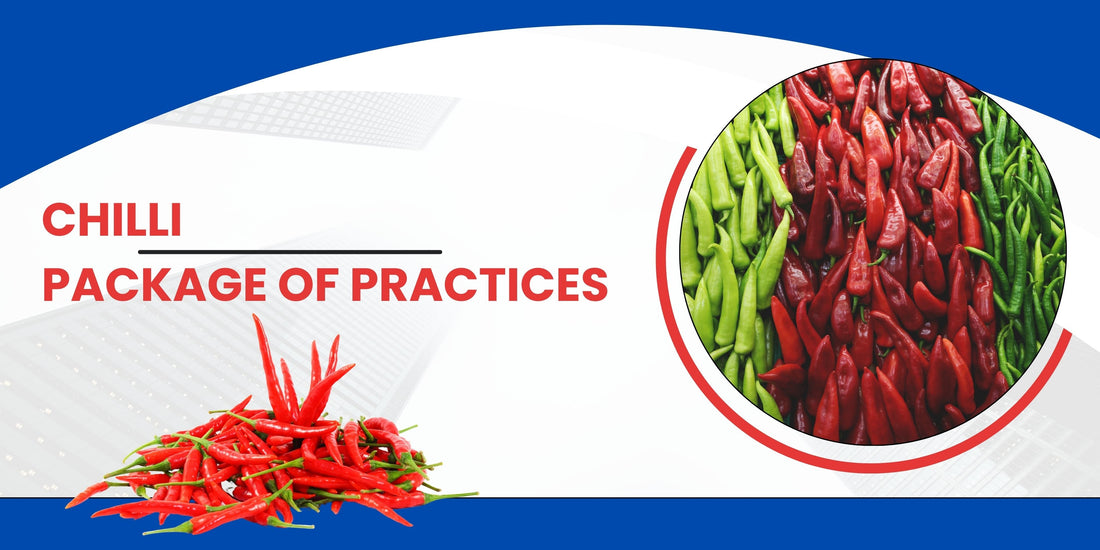
CHILLI PACKAGE OF PRACTICES
Scientific name : Capsicum annuum
Common / Local Name : Chilli/Mirchi
Introduction
Chilli is one of the most important spice crop. India is the largest producer ,consumer and exporter of Chilli contributing about 40 % of the World’s chilli production. In India Andhra Pradesh is the leading state in Chilli production followed by Telangana, Karnataka, and Madhyapradesh. Chilli belongs to the genus Capsicum under Solanaceae family. Five species of Capsicum are under cultivation, through number of wild species have been identified recently. In India, only two species viz. Capsicum annum and Capsicum frutescens are known and most of the cultivated varieties belong to the species Capsicum annum.
Climate and Soils
Chilli requires a warm and humid climate for its best growth and dry weather during the maturation of fruits. It is generally a cold weather crop, but can be grown throughout the year under irrigation. Black soils which retain mositure for long periods are suitable for rainfed crop whereas well drained chalka soils, deltaic soils and sandy loams are good under irrigated condition.
Land preparation
- The land is prepared by giving 5-6 ploughing, compost or FYM @ 150-200 q/ha should be spread and mixed well in the soil at least 15-20 days before sowing.
Nursery bed preparation
Ideal nursery beds should be of 1m width, 40 m long and 15 cm height. Seedlings grown in this bed are enough to transplant in one acre main field. If there is more than one seed bed it’s better to make 30 cm width canals for drainage purpose.
Seed rate
- For Nursery: 650 g seed is sufficient for transplanting in one acre.
- Direct Sowing: 2.5 Kg to 3 Kg per acre
Sowing time
- Kharif: July -August
- Rabi: September- October
Seed Treatment
- Seed treatment for viral diseases: To prevent seed borne viral diseases, seeds should be treated with Trisodium orthophosphate. Dissolve 150 g of Trisodium Orthophosphate in 1 litre water and soak 1 kg seed for 20 minutes in that solution. Remove the chemical water and wash the seed with fresh water for two times and keep the seed for drying under shadow.
- Seed treatment for sucking pest: Treat 1 kg seed with 8 gm Imidacloprid
- Seed treatment for seed borne diseases: For preventing seed borne diseases seeds should be treated with 3g Mancozeb or Capton per Kg seed.
Transplanting
Seedling of 6 weeks age are ideal for transplanting. Spacing for raifed crop should be 60 x 15 cm and for irrigated crop 60 x 60cm or 75 x 60 cm or 90 x 60cm.
Weed control
Mulching helps conserve moisture and nutrients and prevents weed growth. Earthing up should be done 30 days after transplanting. Use of herbicides along with hand weeding is practiced for weed control in chilli.
Irrigation
Irrigate the crops immediately after transplanting and subsequent irrigation at weekly interval.
Nutrient Management
Application of 20 tonnes of FYM and 120kg N, 40-60kg P2O5 and 20-40kg K2O are recommended in majority of states. FYM is applied by broadcasting at the time of final ploughing. Spot application of FYM in furrows or at the point of planting is also followed by farmers. Full dose of P and K and half dose of N is applied 10-15 days after transplanting.
Plant protection
1. Thrips

Scientific name: Scirtothrips dorsalis
SYMPTOMS
-
Generally they attack tender leaves and growing shoots. Rarely the older leaves are attacked. sometimes even the buds and flowers are attacked.
-
Their damage results in the infested leaves curling upward, crumbling and shedding.
-
Silvering of the leaf surface.
-
Infested buds turning brittle with petiole becoming brown and dropping down. Affected fruits showing light brown scars.
MANAGEMENT
-
Seed treatment with imidacloprid @ 3 -5 g/kg of seed.
-
Do not grow chilli after sorghum – more susceptible to thrips
-
Do not follow chilli and onion mixed crop – both the crops attacked by thrips
-
For effective control of thrips we can use bio pesticides like Dr.Eliminator 250ml/acre.
2. Yellow spider mite

Scientific name: Polyphagotarsonemus latus
SYMPTOMS
- The nymphs and adult form webs in the under-surface of the leaves.
- Suck the sap resulting in downward curling of the leaves. Infested leaves appear with elongated petioles.
- The plant looks stunted with reduced growth.
MANAGEMENT
- Foliar spraying of dicofol 5ml/l or wettable sulphur 3g/l.
- Synthetic pyrethroids not to be used.
- For effective control of mites we can use bio pesticides like Dr.Eliminator 250ml/acre.
Disease Management
1. Viral Diseases:
Chilli Leaf curl

Causal organism: Tobacco leaf curl gemini virus
Vectors : Whiteflies (Bemisia tabaci),which feed on infected plants and spread the virus.
Symptoms
- Leaf curling and subsequent size loss are the disease's outward manifestations.
- Plants that are afflicted develop pale yellow leaves. The diseased plant seems to be a witches' broom, the internodes shorten, and the badly affected plants continue to be stunted. In vulnerable cultivars, fruit development is crude and deformed.
Transmission
- The leaf curl virus is spread by whiteflies (Bemisiatabaci) and perennates on a range of annual and perennial hosts in nature.
- Whitefly feed on the plants sap which is why they tend to attack the fresh young growth on plants. Left unchecked they will multiply rapidly and cause lasting damage to the host plants, often stunting their development.
- The whitely also secrete a sticky residue on the plants which then attracts dust and muck and usually causes problems with fungal growths on the leaves.
Mosaic Virus

Causal organism: Tobamo, cucumoviruses and potyviruses.
Vectors : Transmitted by Aphids (eg.,Myzus persicae ).
Symptoms
- The induction of symptoms in chilies varies with respect to the virus associated with the disease. Potato virus Y and its strains generally induce vein banding followed by necrosis of the veins, petioles and stems of chillies.
- Pepper veinal mottle virus causes mosaic mottling, distortion and filliformy of leaves with bushy appearance of the infected plants.
- Pepper severe mosaic produced mosaic mottle, vein clearing and deformation of the infected leaves.
- Tobacco etch virus syndrome includes dark green vein banding, cupping, laminal necrosis of leaves. Cucumber mosaic virus causes mosaic mottling, reduction of leaf lamina and distortion of leaves.
Transmission
All mosaic causing viruses are easily sap transmissible. The members and strains of cucumoviruses and potyviruses are mostly transmitted through aphid vectors Myzuspersicae, Aphis craccivora, Aphis gossypii, Rhopalosiphummaydis in a non persistent manner.
Epidemiology
Epidemiology of the mosaic diseases of chilies depends upon the activity and population of the vector in an area. Temperature affects both virus multiplication as well as buildup of the vector population.
Disease Management of viral diseases
- The infected plants should be uprooted and burnt or buried to avoid further infection.
- Avoid monoculture of chilli crop.
- Raise at least two rows of barrier crops such as maize, sorghum or Pearl millet around your fields .
- Nursery beds should be covered with nylon net or straw to protect the seedlings from viral infection.
- Selection of healthy and diseased - free seed.
- Apply Carbofuran 3G @ 4-5 Kg/acre in the main field to control sucking complex and insect vectors.
- For effective control of vectors we can use bio pesticides like Dr.Eliminator 250ml/acre.
Harvesting and Yield
Flowering takes place two months after transplanting and it takes another month for green fruit. For vegetable purpose, chillies are harvested while they are still green. For drying chillies are harvested at full ripe stage.
Green chilli yield: 75-100q/ha.
Dry chilli yield: 20-25q/ha.
